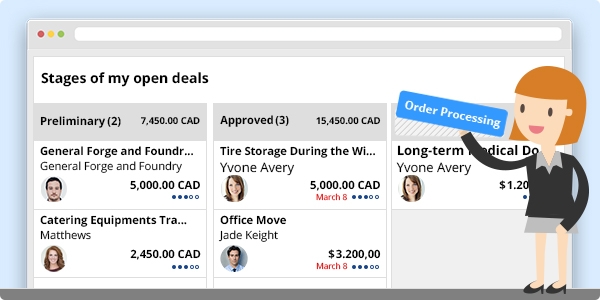New sales opportunities can come and go, but most companies miss out on the fundamentals of bringing efficiency to their sales process.
Fortunately, improving the sales process has become easier with sales-oriented CRMs. By defining and customizing each deal stage in TeamGram, you’ll have more power in taking control of your sales funnel.
Before You Start: Acquiring and Qualifying Leads
First things first: Not all leads are worth your sales team’s time and effort. Before you start sending every lead to sales, make sure that your lead acquisition and qualification processes are defined and operational.
Leads are acquired from various sources: your website’s contact form, emails, phone calls, trade shows, and in-person meetings to name a few. Your customer acquisition funnels are an important lifeline to your business – without testing and optimizing your new lead channels, you’ll lose out potential business opportunities.
However, as many of you know – just because you’ve received a business card doesn’t necessarily mean you have a sale. Once you’ve received a lead, your next step must be to qualify them. It’s highly inefficient to pass every single new potential customer to your sales team – many of those leads may not be ready to buy.
For more information about why you should qualify your leads, read our guide to lead qualification here.
Defining the Deal Stages
With a fresh list of qualified leads, your sales team is ready to start working on new deals. Although the road to closing a sale may take weeks or even months, businesses find identifying the individual stages for their deal process and defining specific actions assigned to each stage the most efficient.
Defining stages helps you identify the sales progress for each customer, giving you an opportunity to monitor the bottlenecks in your sales funnel. For example, stages let you see the deals that are stuck at “awaiting customer approval”, or identify the number of deals lost without reaching the negotiation stage. Monitoring your deals stages and identifying problems at each stage is crucial for optimizing sales. Deal stages also allow you to see the potential outcome of all your existing deals. When a sales probability is assigned to each of your deal stages, you’ll be able to make a more accurate revenue forecast based on your current pipeline.
Although deal stages vary from business to business, they make it easier for decision makers to understand what needs to be done to close a deal at each stage.
Deal Stage 1: First sales contact
After qualifying your leads, it’s time to pass them onto your sales team to begin the sales and negotiation process. This is where the sales team will most likely email, phone call, meet up, and create a dialogue with your customers – discussing the benefits of your service or product, and enticing them to make a purchase. Your CRM should be able to track and monitor each conversation that happens – especially for new customers early in the sales cycle. If you’re finding many of your customers are stuck at this stage, you may want to look at how you’re qualifying your leads.
Deal Stage 2: Request for proposal
Not all customer contacts advance through the deal flow, some drop-out and some result with a request for a proposal. Knowing which customers decided to proceed to the proposal request stage is a good indicator of who your prospective customers are. If most of the customers are lost before the request for proposal stage, you may want to check your initial contact strategy since your contacts may not be moving forward in your sales funnel.
Deal Stage 3: Creating and sending a proposal
Great – your sales team has understood the needs of your customer, confirmed higher interest from the customers, and is ready to create and submit a proposal. This means, the customers who proceed along the sales funnel up to this stage are the ones that are most likely to convert soon.
Deal Stage 4: Ongoing negotiations and proposals revisions
As your sales team continues negotiations with the deal, they can make the necessary revisions directly from the CRM. You may want to have a closer look into what is happening with each customer at this specific stage. The probability to convert is even higher, so customers would need more attention at this stage of the deal.
Deal Stage 5: Closing the deal
Once the deal has been approved – and the sales team has finished celebrating – your CRM can instantly convert your proposal or deal into an order for immediate fulfillment. By tying it together with different product and contact records, the order can be easily completed and tracked post-sale. Managers can then track all ongoing and completed deals for better understanding of the sales process.
However not every deal results in a happy ending; you can still learn from unsuccessful sales. What was their reason for declining your proposal? Is this a recurring case? Without defining and monitoring your deal stages closely, you’ll miss important clues that may give you the proper insight for future improvements. Therefore customization becomes crucial here – getting into the details of why deals were lost would help identify main pain points at the end of your deal stages.
By taking steps to improving each deal stage, managing your sales process becomes both easier and more profitable. Focusing on your best quality leads, followed by deal negotiations over revised proposals, then closing it and beginning fulfillment, your customers will experience a seamless and intuitive sales process from your company.
Every business operates differently. Sales management CRMs provide businesses with the necessary tools to create and monitor individual deal stages. Combining them with numerous other CRM benefits, businesses can be easily equipped to sell more efficiently and keep deals from falling through the cracks.
